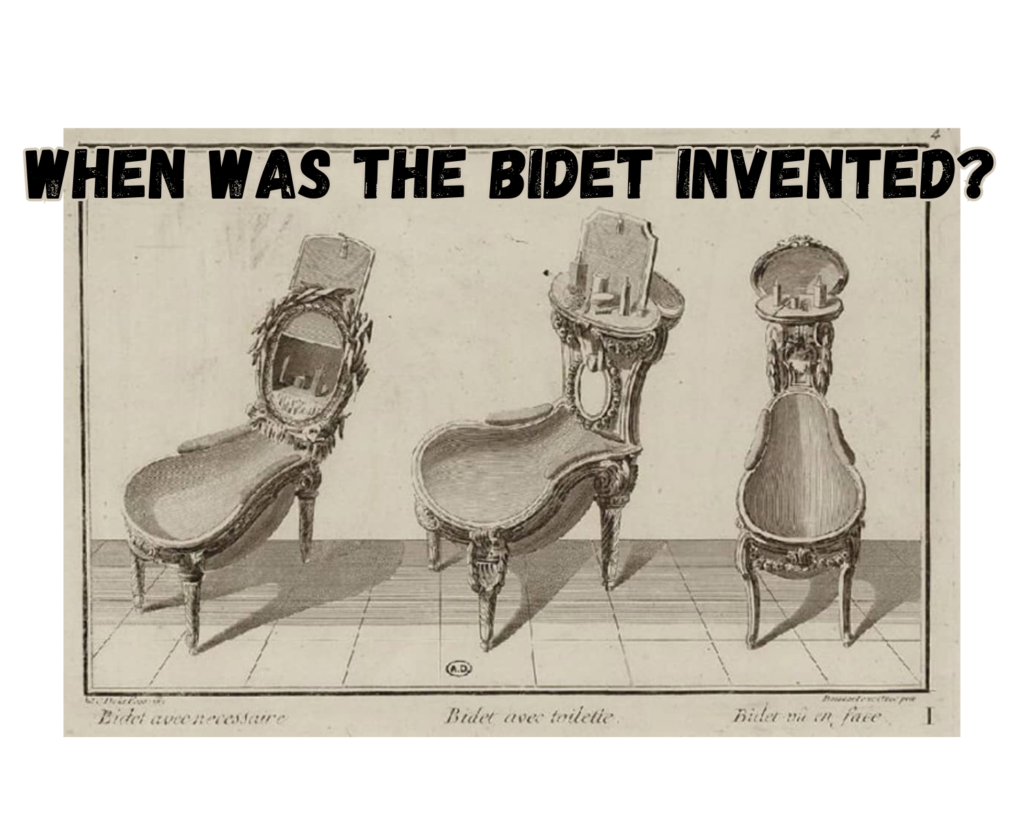The concept of cleanliness has evolved over centuries, and one invention that has significantly impacted personal hygiene is the bidet. But when was the bidet invented, and how did it become a staple in bathrooms around the world? This article delves into the fascinating history of the bidet, exploring its origins, evolution, and cultural significance.

The Bidet’s Role in Modern Hygiene
The bidet has gained recognition for its effectiveness in promoting hygiene and environmental sustainability. As more people become conscious of their health and the environment, understanding the bidet’s history and impact is crucial. By using a gentle stream of water, bidets offer a superior clean compared to toilet paper alone, contributing to better personal hygiene and less environmental waste.
From its early beginnings in France to its widespread adoption across continents, the bidet has become an essential bathroom fixture for many. This article will explore the journey of the bidet, from its invention to its modern-day innovations, and answer the burning question: When was the bidet invented?
For those curious about why bidets are becoming increasingly popular today, check out this guide on the benefits of using a bidet.

The Origins of the Bidet
The bidet has a long and fascinating history, beginning as a luxury item for the wealthy and eventually becoming a common fixture in bathrooms worldwide. Understanding when the bidet was invented requires a journey back to 17th-century France, where the concept first took root.
The Birth of the Bidet: When Was It Invented?
The bidet is believed to have been invented in the late 1600s in France, specifically around 1680. Its origins are somewhat murky, as detailed historical records are scarce. The word “bidet” itself is derived from the French term for “pony,” which aptly describes the straddling position one would take when using the early versions of the device.
Who Invented the Bidet?
The exact inventor of the bidet remains unknown, though some credit its creation to French furniture makers of the time. Christophe Des Rosiers, a furniture maker to the French aristocracy, is often mentioned as a possible creator due to his innovations in personal hygiene furniture. The bidet quickly became popular among French nobility, who valued cleanliness and luxury.
Early Bidet Designs
The earliest bidets were simple basins or tubs with a water source, often made from porcelain or wood. These standalone fixtures were placed in bedrooms rather than bathrooms, reflecting the sanitary practices of the time. The original design was straightforward, focusing on function rather than form.
Early Features:
- Manual Operation: Users filled the basin with water manually, and some designs included a hand pump to provide a gentle stream of water.
- Portable and Versatile: Unlike today’s integrated bidet systems, these early models were portable, allowing them to be moved around the household as needed.
- Luxury Item: Initially, bidets were luxury items available only to the wealthy, symbolizing status and sophistication.
The Bidet’s Journey to Popularity
Despite its humble beginnings, the bidet’s practical benefits soon led to its spread beyond French aristocracy. By the 18th century, the use of bidets had expanded across Europe, especially in countries like Italy and Spain, where personal hygiene was highly valued.
For more insights into why bidets have become a staple in modern bathrooms, explore this detailed guide on the reasons people choose to use bidets.

Evolution of the Bidet Through History
The bidet has undergone significant transformations since its inception in the late 17th century. From a basic, manual device used by the French aristocracy to a modern, technological marvel available to everyone, the evolution of the bidet reflects changing attitudes toward hygiene and personal care.
How Has the Bidet Evolved Over Time?
The evolution of the bidet can be divided into several key phases, each marked by innovation and adaptation to the needs of users.
1. From Standalone to Integrated Designs
In the 19th century, the bidet began to transition from a standalone fixture to a more integrated bathroom feature. This change coincided with advancements in plumbing and bathroom design, allowing for more convenient and sanitary use.
- Integration with Toilets: In the early 1900s, the bidet started to be incorporated into the toilet design, primarily in Europe. This integration helped save space and make the device more accessible to a broader audience.
- Improved Plumbing Systems: The introduction of indoor plumbing allowed bidets to be connected directly to water lines, eliminating the need for manual water filling and making them more hygienic.
2. Technological Advancements
The latter half of the 20th century saw significant technological advancements that transformed bidets into high-tech devices with a range of features.
- Electric Bidets: The 1960s and 1970s introduced electric bidets with heated seats, adjustable water pressure, and temperature controls, making them more comfortable and user-friendly.
- Smart Bidets: Today’s smart bidets offer features like remote control operation, air drying, deodorizing, and even music, showcasing the potential for luxury and convenience in modern bathrooms.
For those interested in the latest innovations, check out this guide to the best bidets available today, which highlights top models that combine comfort and technology.
3. Rise of Bidet Attachments and Portable Options
The rise of bidet attachments and portable bidets has made this hygienic tool accessible to even more people worldwide.
- Bidet Attachments: These affordable devices easily attach to existing toilets, offering a simple solution for those looking to upgrade their hygiene without a complete bathroom overhaul.
- Portable Bidets: Compact and convenient, portable bidets provide the benefits of bidets for travelers or those with limited bathroom space.

What Were Early Bidet Designs Like?
Early bidet designs were quite different from the sleek models we see today. Originally, they were made of wood or porcelain and resembled a large basin or low sink. Users would fill the basin with water manually and use a small pitcher or pump to wash.
- Antique Aesthetics: The craftsmanship of antique bidets often reflected the artistry of the time, with ornate designs and elegant finishes.
- Functional Simplicity: Despite their luxury status, early bidets were simple in function, emphasizing practicality over sophistication.
Examples of Early Designs:
- Porcelain Basins: These were often ornately decorated and found in the homes of the wealthy.
- Wooden Tubs: Early wooden bidets were portable and could be moved as needed.
Modern Innovations in Bidet Technology
Modern bidets have evolved far beyond their original designs, with a focus on user comfort and technological innovation.
- Eco-Friendly Features: Modern bidets are designed with sustainability in mind, reducing toilet paper usage and offering energy-saving modes.
- Customizable Settings: Today’s bidets offer personalized settings for water temperature, pressure, and nozzle position, catering to individual preferences.
- Integration with Smart Home Technology: Some bidets can be connected to smart home systems, allowing for remote operation and integration with other smart devices.
Cultural Significance and Global Adoption
Bidets have traveled far from their origins in 17th-century France, becoming a significant part of bathroom culture worldwide. While some regions have fully embraced the bidet as a staple of everyday life, others are just beginning to discover its benefits. This section explores how bidets have become culturally significant in different parts of the world and their adoption on a global scale.
How Did Bidets Become Popular Worldwide?
The spread of the bidet from Europe to other parts of the world is a fascinating journey marked by cultural exchanges and changing attitudes toward hygiene. Here’s how it unfolded:
1. Bidet Adoption in Europe
- France: The birthplace of the bidet, France has long been a champion of this hygiene tool. Initially a luxury for the aristocracy, bidets became common in French homes over the centuries.
- Italy and Spain: These countries quickly embraced bidets, and they are now standard fixtures in bathrooms across Italy and Spain. The warm climate and cultural emphasis on cleanliness have contributed to their popularity.
- United Kingdom: Although the bidet was initially less common in the UK, increasing awareness of its benefits has led to a gradual rise in adoption.
2. Bidets in Asia
- Japan: Japan is perhaps the most innovative when it comes to bidet technology. Known for their high-tech toilets with integrated bidet functions, Japanese bathrooms often include features like heated seats, music, and even health monitoring.
- South Korea: Similar to Japan, South Korea has embraced advanced bidet technology, making them a popular choice in modern bathrooms.
- Middle East: Bidets are widely used in Middle Eastern countries, where personal hygiene is of cultural importance, and the use of water for cleansing is a traditional practice.
3. North America
- United States: In the U.S., bidet adoption has been slower, but it’s gaining momentum as more Americans become aware of their environmental and hygiene benefits. The rise of bidet attachments and portable options has made them more accessible to the American market.
- Canada: Similar to the U.S., Canada is seeing a growing interest in bidets, with many households adopting bidet attachments as a cost-effective solution.
4. Global Impact and Awareness
Bidets have had a significant impact on global hygiene practices, influencing how people approach personal cleanliness and environmental sustainability. They are celebrated not only for their efficiency but also for their ability to conserve resources, such as toilet paper.
For more insights into how bidets are making a difference today, explore this guide on why people choose to use bidets.

The Cultural Significance of Bidets in Different Countries
Bidets hold different cultural significance depending on the region, reflecting diverse attitudes and practices related to hygiene. Here’s a look at how bidets are perceived in various parts of the world:
- France: In France, the bidet symbolizes a commitment to hygiene and sophistication, rooted in centuries of use among the elite.
- Japan: Bidets in Japan are a testament to technological innovation and luxury, often associated with modernity and convenience.
- Italy: In Italy, bidets are seen as essential bathroom fixtures, emphasizing the cultural importance of cleanliness and comfort.
- Middle East: In Middle Eastern countries, bidets align with traditional practices of using water for purification, reinforcing cultural norms around cleanliness.
- United States: As bidets gain popularity in the U.S., they represent a shift toward more sustainable and eco-friendly bathroom practices.
Famous Historical Figures and Bidet Promotion
Throughout history, several notable figures have been associated with the promotion and use of bidets:
- Napoleon Bonaparte: Known for his meticulous hygiene practices, Napoleon reportedly favored the use of bidets for their effectiveness in personal cleanliness.
- Queen Victoria: It is said that Queen Victoria had a bidet installed at Windsor Castle, reflecting its status as a luxury item among the elite.
- Marilyn Monroe: The Hollywood icon was known to have a fondness for bidets, highlighting their appeal beyond Europe.
For those interested in upgrading their bathroom with modern bidets, check out this guide to the best bidets for comfort and cleanliness, offering insights into top-rated models.
Modern Innovations and Impact on Hygiene
Bidets have come a long way from their origins as simple basins for the French aristocracy. Today, they are sophisticated devices that offer a range of features designed to enhance comfort, hygiene, and convenience. This section explores the modern innovations in bidet technology and their impact on personal hygiene.

Modern Bidet Innovations: How Have They Improved?
Modern bidets are equipped with a variety of features that cater to diverse user needs, providing an unparalleled hygiene experience. Here are some of the key innovations that have transformed the bidet into a must-have bathroom fixture:
1. Technological Advancements
- Electric Bidets: Electric bidets are now standard in many homes, offering features like heated seats, warm water washes, and adjustable water pressure. These advancements ensure a comfortable and personalized experience for every user.
- Smart Bidets: Some of the most advanced bidets are now integrated with smart home technology. Features like remote control operation, customizable settings, and even health monitoring capabilities make them an integral part of modern smart homes.
- Self-Cleaning Nozzles: To maintain hygiene, many bidets now come with self-cleaning nozzles that automatically sanitize after each use. This innovation ensures the bidet remains clean and safe for everyone.
2. Eco-Friendly Features
- Water Efficiency: Modern bidets are designed to use water efficiently, providing a thorough clean while minimizing water waste. This makes them an environmentally friendly alternative to traditional toilet paper.
- Reduced Toilet Paper Usage: By relying on water for cleaning, bidets significantly reduce the need for toilet paper, helping to conserve natural resources and reduce waste.
3. User-Friendly Designs
- Ease of Installation: Bidet attachments and toilet seats have become incredibly easy to install, allowing users to upgrade their bathrooms without professional help. This accessibility has contributed to the growing popularity of bidets in various regions.
- Customizable Settings: Users can adjust settings such as water temperature, pressure, and nozzle position to suit their preferences, ensuring a comfortable experience for everyone.
For those interested in exploring top-rated bidets and their features, check out this guide to the best bidets available.
What Impact Have Bidets Had on Personal Hygiene?
The impact of bidets on personal hygiene is profound, offering a more effective and comfortable way to maintain cleanliness. Here’s how bidets have changed hygiene practices for the better:
1. Superior Cleanliness
- Water vs. Toilet Paper: Water is more effective at removing waste and bacteria than toilet paper alone, making bidets a superior option for maintaining cleanliness. This is particularly beneficial for individuals with sensitive skin or conditions like hemorrhoids.
- Gentle and Soothing: The gentle stream of water provides a soothing experience, reducing irritation and discomfort often associated with toilet paper.
2. Health Benefits
- Reduction in Infections: By providing a more thorough clean, bidets can help reduce the risk of infections such as urinary tract infections (UTIs) and other hygiene-related issues.
- Improved Comfort: For those with medical conditions or mobility challenges, bidets offer a more accessible and comfortable solution for personal hygiene.
3. Environmental Impact
- Sustainability: Bidets contribute to environmental sustainability by significantly reducing the need for toilet paper. This not only conserves trees but also decreases the energy and water used in toilet paper production.
- Waste Reduction: With less toilet paper being used, there is a notable reduction in bathroom waste, supporting a cleaner and more sustainable environment.
Modern Bidets as a Hygiene Revolution
Modern bidets have revolutionized personal hygiene by offering features that cater to a wide range of needs and preferences. Whether it’s through technological advancements or eco-friendly designs, bidets provide a cleaner, more sustainable option for maintaining personal hygiene. Their continued evolution and adoption signify a shift towards more mindful and efficient hygiene practices.

The Importance of Bidets Today
As we navigate a world increasingly focused on sustainability, personal health, and technological convenience, the relevance of bidets continues to grow. No longer just a European luxury, bidets have become a key fixture in bathrooms across the globe, offering a myriad of benefits that align with modern lifestyles.
Why Are Bidets Important in Today’s World?
The increasing popularity of bidets can be attributed to several factors that resonate with contemporary values and needs:
1. Enhanced Hygiene
Bidets provide a level of cleanliness that toilet paper simply can’t match. By using a gentle stream of water, bidets effectively remove bacteria and residue, offering a superior cleaning experience. This enhanced hygiene is crucial for those with sensitive skin or specific medical conditions, such as hemorrhoids or urinary tract infections.
Impact on Health: The ability of bidets to reduce irritation and promote cleanliness contributes to overall health and well-being, making them an essential tool in personal care.
2. Environmental Benefits
In an era where environmental conservation is paramount, bidets offer a sustainable alternative to toilet paper. By significantly reducing toilet paper usage, bidets help conserve trees, reduce manufacturing waste, and minimize the carbon footprint associated with paper production.
Sustainable Living: For eco-conscious individuals and households, using a bidet is a simple yet effective way to contribute to environmental preservation.
3. Cost Savings
Though the initial investment in a bidet may seem daunting, the long-term savings on toilet paper make it a cost-effective choice. By drastically cutting down on paper consumption, households can save money over time, making bidets a smart financial decision.
Economic Advantages: As more people recognize the economic benefits of bidets, their adoption continues to rise, reinforcing their importance in modern living.
4. Technological Integration
Modern bidets have embraced technological advancements, offering features that enhance convenience and comfort. From heated seats and customizable settings to smart home integration, bidets cater to the desire for luxury and ease in everyday life.
Technological Appeal: The integration of technology in bidet design makes them appealing to tech-savvy individuals seeking to upgrade their bathroom experience.
For those exploring the benefits and innovations of bidets, this article on why people choose to use bidets provides further insights into their growing appeal.
Finding the Best Bidets for Your Home
With numerous options available, finding the best bidet for your home requires understanding your specific needs and preferences. Here are some considerations to keep in mind:
- Budget: Determine your price range and explore bidets that offer the best value for your money.
- Features: Consider what features are most important to you, such as heated water, adjustable pressure, or self-cleaning nozzles.
- Installation: Decide whether you want a bidet that requires professional installation or a DIY-friendly model.
- Space: Ensure that the bidet fits within your bathroom’s dimensions and complements your existing fixtures.
For a detailed guide on top-rated bidets, check out this resource on the best bidets for comfort and cleanliness, offering insights into the latest models and features.
When Was the Bidet Invented, and Why Does It Matter?
The bidet, invented in the late 17th century, has come a long way from its beginnings as a luxury item for French nobility to a standard fixture in bathrooms worldwide. Understanding when the bidet was invented allows us to appreciate its historical significance and the technological advancements that have transformed it into an essential tool for modern hygiene.
The Journey from Invention to Innovation
The bidet’s journey from a simple basin in 17th-century France to the technologically advanced models available today reflects changing attitudes toward personal hygiene, comfort, and environmental responsibility. Over the centuries, the bidet has evolved from a niche luxury to a practical and accessible solution for people everywhere.
Why Knowing the Bidet’s History Matters
- Cultural Understanding: The bidet’s evolution highlights cultural attitudes toward cleanliness and the ways in which different societies prioritize hygiene. Knowing its history gives us insight into these cultural dynamics and the role of innovation in meeting human needs.
- Technological Advancement: Understanding the historical development of bidets showcases how technological advancements have enhanced our daily lives, making essential practices more efficient and effective.
- Environmental Awareness: The transition from traditional paper-based cleaning methods to water-based solutions reflects a growing awareness of environmental issues and the need for sustainable living practices.
The Modern Relevance of Bidets
In today’s world, bidets are more important than ever. They offer a cleaner, more sustainable alternative to toilet paper, contributing to both personal health and environmental conservation. The bidet’s ability to reduce irritation, prevent infections, and promote overall hygiene makes it a valuable asset in the pursuit of a healthier lifestyle.
Embrace the Change: As we continue to prioritize sustainability and well-being, the adoption of bidets is a logical step toward a cleaner and more responsible future. By understanding the history and evolution of the bidet, we can appreciate its impact on modern hygiene and the benefits it brings to our daily routines.
For those interested in discovering the best bidet options for enhancing their bathroom experience, explore this guide on top-rated bidets for comfort and cleanliness.

Whether you’re new to the concept of bidets or looking to upgrade your bathroom, now is the perfect time to embrace this innovative hygiene solution. The benefits of using a bidet are clear, and its continued evolution promises even greater advancements in the future.
By making the switch to a bidet, you join a growing community of individuals who prioritize health, hygiene, and environmental responsibility. Explore more about why bidets are becoming an essential part of modern life by reading this comprehensive article on the benefits of bidets.
As an Amazon Associate we earn from qualifying purchases through some links in our articles.


